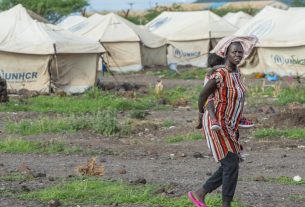The other side
Suffering doesn’t stop at borders or frontlines. On the other side of the divide, not far from where Ahmed lives, lies Aleppo.
A skyscape as scarred as its population by years of siege and ferocious shelling that lay ruin to half the city. The earthquakes brought new devastation to both intact and already damaged buildings.
Some 10% of the 2 million inhabitants took refuge in more than 200 mosques and schools. In these collective shelters, with several families in a room, many are waiting for their building to be declared safe to return home.
© Photo 1: European Union, 2023 (photographer: Anouk Delafortrie) – Photo 2: ICDA NGO/Ange Hussein
Others, like 66-year-old Sanaa, have no option but to stay since her apartment is now uninhabitable. She guides us outside the boisterous school corridors to meet her 73-year-old husband, Samir.
“There are 12 families in ‘our’ classroom, so we sleep in the car,” Sanaa says, standing in front of a small truck covered with plastic sheeting.
“We’ve had to leave our home 3 times in the past 12 years. We are respectable people. We don’t want to be beggars but have nowhere to go,” she says, no longer holding back tears.
“We need food. Our clothes are torn. We only have a few things, and they are all gone,” Sanaa.
When Samir retired in 2010, they never imagined they would have to survive the war, bombardments, poverty, and an earthquake. His monthly retirement pension is the equivalent of €13 in today’s struggling economy, and the vehicle is their last possession.

© Photo 1: European Union, 2023 (photographer: Anouk Delafortrie) – Photo 2: DRC
EU humanitarian partners are helping people in the shelters with health care, counselling, hygiene, and other essential aid.
However, the situation in the shelter isn’t sustainable. It is overcrowded and lacks of proper sanitation, making disease outbreaks more likely with every passing day.
Before the earthquake, humanitarian needs were already at an all-time high in Syria. With crisis after crisis shaking people to their core, pushing them to the edge of survival, donor fatigue is not an option.
In addition to EU humanitarian aid, the EU Civil Protection Mechanism was activated 2 days after the quake. Via Türkiye and Lebanon, 16 European countries provided aid to opposition-held and government-controlled areas. The EU also sent relief from its humanitarian stockpiles to both sides.
As one of the major donors for aid to Syrians, the EU has maintained a stable level of humanitarian funding in recent years. Despite many challenges, the EU has been providing impartial humanitarian aid to people in Syria since 2011, on all sides of the conflict.
Story by Anouk Delafortrie, Regional Information Officer for Middle East and Nothern Africa, EU Civil Protection and Humanitarian Aid Operations.
Publication date: 15/03/2023



